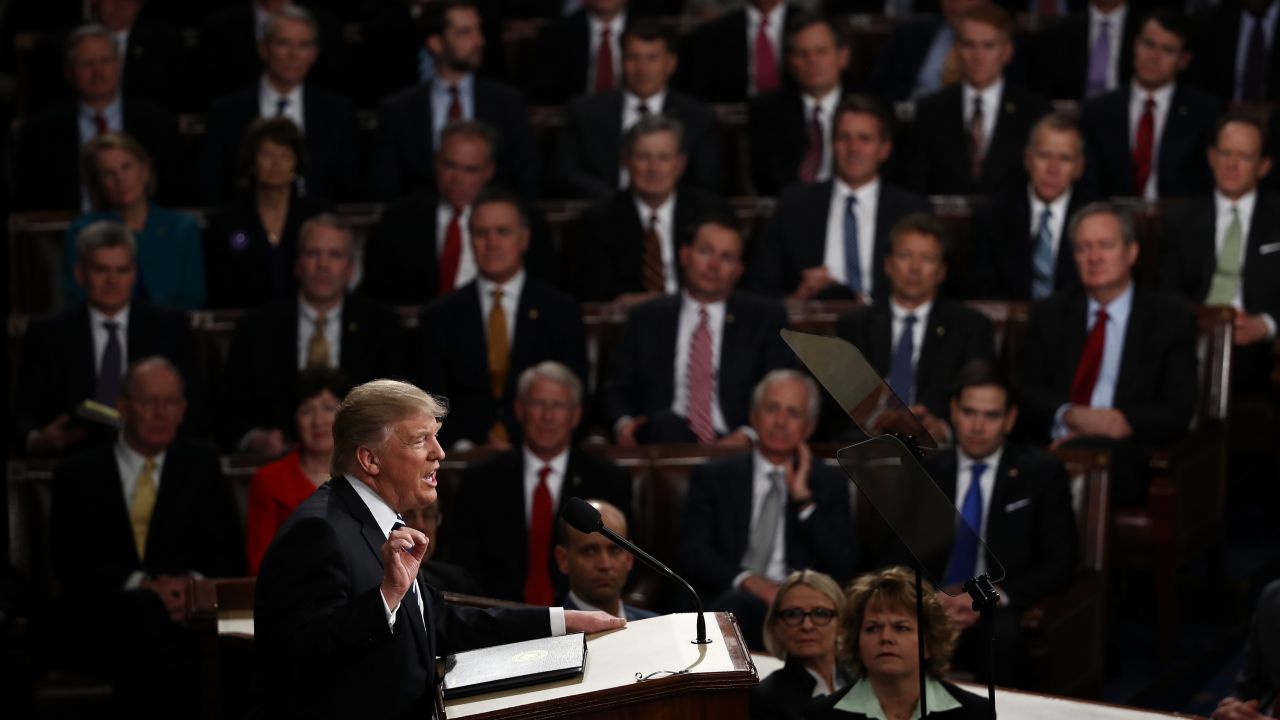
U.S. President Donald Trump addresses a joint session of the U.S. Congress on February 28, 2017 in the House chamber of the U.S. Capitol in Washington, DC. Trump's first address to Congress focused on national security, tax and regulatory reform, the economy, and healthcare. (Photo by Win McNamee/Getty Images)
This post originally appeared at The Nation.
Donald Trump used his first Joint Address to the Congress of the United States to engage in an unprecedented flight of fiscal fantasy. Specifically, the president imagined that the United States could cut taxes for wealthy Americans and corporations, rip tens of billions of dollars out of domestic programs (and diplomacy), hand that money over to the military-industrial complex and somehow remain a functional and genuinely strong nation.
Trump did not articulate this agenda quite so bluntly. His hour-long speech was far more traditional and temperate in character than his ballistic inaugural address. The themes were, for the most part, predictable: “construction of a great wall along our southern border,” “vetting procedures,” “for every one new regulation, two old regulations must be eliminated,” “school choice,” “construction of the Keystone and Dakota Access Pipelines.” The rhetoric was, by the standards of this presidency, disciplined. But the specifics were few. Only toward the end did the president get specific, saying, “I am sending the Congress a budget that rebuilds the military, eliminates the Defense sequester and calls for one of the largest increases in national defense spending in American history.”
Trump was not at all specific about paying for that increase — aside from mentioning the fact that he had “placed a hiring freeze on non-military and non-essential Federal workers.” But his administration has been clear about its hope that the money will come from deep cuts to domestic programs.
This argument in favor of austerity for working families and munificence for military contractors (the president’s speech actually talked up Lockheed and “the fantastic new F-35 jet fighter”) is not exactly new. It has been a conservative mantra since the Grand Old Party purged itself of the “Modern Republicans” who clung to the vision of former President Dwight Eisenhower and made theirs a party of reaction rather than reason. But even Ronald Reagan and George W. Bush eschewed the budgetary extremism that Trump has embraced with an immediacy and a fervor that arrests any fantasy that a “billionaire populist” president might steer his adopted party back from the brink.
The “Budget Blueprint” that Trump took to Congress on Tuesday night did not plot a course to “make America great again.” It tipped the balance against greatness by making what the first Republican president, Abraham Lincoln, referred to as “the last best hope of Earth” into an ever more heavily militarized state that will not care for its own.
This is not an accidental turn.
This is by design. But it is not a grand design; rather, it is an approach that Trump has adopted as he has moved from the capricious politics of his initial candidacy to the reality of a ever more rigidly right-wing presidency.
Mick Mulvaney, Trump’s man at the Office of Management and Budget, said on the eve of the president’s “Budget Blueprint” speech, “The president is doing what he said he’d do when he ran.” But Trump said a lot of things when he was bidding for the presidency in 2016: He made big promises about jobs and infrastructure, delivering more and better health care, protecting Social Security and Medicare. He portrayed himself as a critic of the war in Iraq, a skeptic about new military adventures and a critic of “the fraud and abuse and everything else” in bloated Department of Defense budgets. “I’m gonna build a military that’s gonna be much stronger than it is right now,” he announced on NBC’s Meet the Press in 2015. “It’s gonna be so strong, nobody’s gonna mess with us,” he promised. “But you know what? We can do it for a lot less.”
That seemed reasonably definitive.
Yes, of course, Trump bounced all over the ideological landscape during the 2016 campaign, and his presidency hasn’t exactly been a model of consistency.
Even with that fact in mind, however, it must have surprised at least a few Trump backers to learn from Mulvaney that bloating up the Pentagon budget was such a high priority of the Trump campaign. “What you see in this budget,” the budget director explained Tuesday, “is exactly what the president ran on. He ran on increasing spending on the military…”
Mulvaney was unsettlingly vague when asked about keeping Trump’s promise to guard against Social Security cuts. But he was clear about the general thrust of the administration’s approach to budgeting.
— President Eisenhower
“[We] took $54 billion out of non-defense discretionary spending in order to increase defense spending — entirely consistent with what the president said that he would do,” Mulvaney explained. “So what’s the president done? He’s protected the nation, but not added any additional money to the 2018 deficit. This is a winning argument for my friends in the House and a winning argument for a lot of folks all over the country. The president does what he says but doesn’t add to the budget [deficit]. That’s a win.”
Mulvaney is wrong. That’s not a win.
That does not protect America — at least not in the sense that Democratic and Republican presidents have historically understood the preservation of the republic. Budgeting is always a matter of striking balances. And when there is an imbalance, the American experiment is threatened.
Dwight Eisenhower explained this when he appeared barely two months into his presidency before the American Society of Newspaper Editors. The speech was much anticipated. Eisenhower was the first Republican commander in chief in two decades, and he was still placing his imprint on the Oval Office, the country and a world that was in the grips of a “Cold War.” The new president could have chosen any topic for his first major address to the assembled media luminaries. He chose as his topic the proper balancing of budget priorities.
Eisenhower recognized the threats that existed. He spoke, at length, about difficult relations between the United States and the Soviet Union and he addressed the threat of annihilation posed by the spread of atomic weaponry. But the career military man — the supreme commander of the Allied Expeditionary Forces in Europe during World War II, the chief of staff of the Army during the postwar era when tensions with Moscow rose — did not come to suggest that increased defense spending was a singular priority. In fact, his purpose was the opposite. He spoke of the “dread road” of constant military escalation and warned about “a burden of arms draining the wealth and the labor of all peoples; a wasting of strength that defies the American system or the Soviet system or any system to achieve true abundance and happiness for the peoples of this earth.”
“Every gun that is made, every warship launched, every rocket fired signifies, in the final sense, a theft from those who hunger and are not fed, those who are cold and are not clothed,” said Eisenhower, who explained that
This world in arms is not spending money alone.
It is spending the sweat of its laborers, the genius of its scientists, the hopes of its children.
The cost of one modern heavy bomber is this: a modern brick school in more than 30 cities.
It is two electric power plants, each serving a town of 60,000 population.
It is two fine, fully equipped hospitals.
It is some 50 miles of concrete highway.
We pay for a single fighter with a half million bushels of wheat.
We pay for a single destroyer with new homes that could have housed more than 8,000 people.
This, I repeat, is the best way of life to be found on the road the world has been taking.
This is not a way of life at all, in any true sense. Under the cloud of threatening war, it is humanity hanging from a cross of iron.
Eisenhower did not propose surrender or immediate disarmament. But he did propose diplomacy (“We welcome every honest act of peace”), and the sincere pursuit of a world with fewer weapons and fewer excuses for war making (“This we do know: a world that begins to witness the rebirth of trust among nations can find its way to a peace that is neither partial nor punitive”).
“The fruit of success in all these tasks would present the world with the greatest task, and the greatest opportunity, of all,” explained Eisenhower. “It is this: the dedication of the energies, the resources and the imaginations of all peaceful nations to a new kind of war. This would be a declared total war, not upon any human enemy but upon the brute forces of poverty and need.”
“The monuments to this new kind of war would be these: roads and schools, hospitals and homes, food and health,” the new president concluded. “We are ready, in short, to dedicate our strength to serving the needs, rather than the fears, of the world.”
These are different times. The world has changed, and so has the United States. But what has changed the most is the understanding that providing for the common defense does not preclude the promotion of the general welfare.
Conservatives like to say “there is no free lunch,” and that is true enough when it comes to budgeting. It is not possible to move tens of billions of dollars out of domestic programs that have already in many cases been squeezed to austerity levels and into a military budget so vast, the National Priorities Project reports, that “US military expenditures are roughly the size of the next seven largest military budgets around the world, combined.”
On a planet where Americans account for 4.34 percent of the population, US military spending accounts for 37 percent of the global total. And Trump — with Mulvaney’s assistance — appears to be determined to move the latter percentage upward.
That is a problematic imbalance in itself. But what makes it even more problematic is Mulvaney’s signal that, under Trump, the imbalance will be maintained not by collecting new revenues but by redistributing money that could have been spent on health care and housing and education at home — and on the international diplomacy and foreign aid that might actually reduce the need for military expenditures. “While Trump claims he’s serious about great negotiation, his plan to pillage funds from the State Department and foreign aid to feed the insatiable Pentagon budget says otherwise,” notes Peace Action Executive Director Jon Rainwater. Instead of putting Americans first, Trump “plans to line the arms industry’s pockets by cutting programs like health care that provide real security to American families says otherwise.”
This is the realization of the worst fears that Eisenhower addressed, not just in his 1953 “Cross of Iron” speech but in the final address of his presidency, which warned that “we must guard against the acquisition of unwarranted influence, whether sought or unsought, by the military-industrial complex.”
“We must never let the weight of this combination endanger our liberties or democratic processes,” said the 34th president. “We should take nothing for granted. Only an alert and knowledgeable citizenry can compel the proper meshing of the huge industrial and military machinery of defense with our peaceful methods and goals so that security and liberty may prosper together.”




